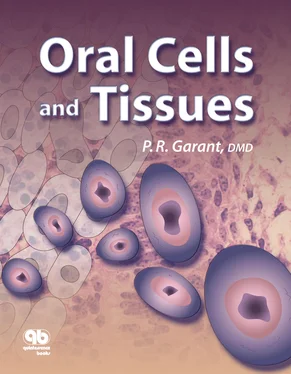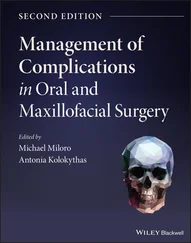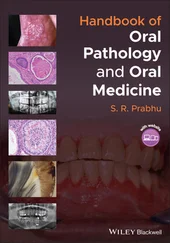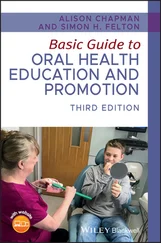Cellular retinol-binding proteins (CRBPs) and cellular retinoic acid–binding proteins (CRABPs) are involved in the metabolism and storage of vitamin A metabolites in the cytoplasm. Cellular retinol-binding proteins and CRABPs may control the level of free RA available to interact with the nuclear RARs. Because a nuclear RAR and an RA response element control the gene responsible for coding EGF, the ability of RA to increase cell proliferation may be mediated through increased EGF production (see Figs 1-13aand 1-13b). The site-specific increase in epithelial cell division required for the formation of the dental lamina and the subsequent development of tooth buds could be controlled by localized production of EGF in response to RA. 51 , 53 , 54 , 60
Both RARs and CRABPs have been localized in the dental lamina and adjacent ectomesenchyme as well as in dental epithelium and ectomesenchymal components of developing teeth (see Figs 1-13aand 1-13b). 51,53,54In addition, CRABPs have been localized in the epithelium adjacent to sites of dental lamina formation, suggesting that RA may be bound at such sites. In the dental lamina, where there appears to be fewer CRABPs, the RA molecules are free to interact with their nuclear receptors and thereby increase the expression of EGF. 54
Figs 1-13a and 1-13bRole of vitamin A during tooth formation.
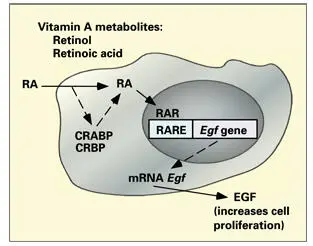
Fig 1-13aCellular action. Retinoic acid (RA), the major active metabolite of vitamin A, diffuses into the cell interior, where it binds to cellular retinoic acid–binding protein (CRABP), or, if the level of CRABP is low, may enter the nucleus to interact with its receptor (RAR). Retinoic acid receptors activate retinoic acid response elements (RARE) that regulate gene transcription, thereby stimulating the production of messenger ribonucleic acid (mRNA). The epidermal growth factor gene ( Egf ) is regulated by a RAR-RARE complex. The increase in cell proliferation effected by vitamin A is believed to be the result of the secretion of epidermal growth factor (EGF), a known mitogen for dental epithelium and ectomesenchyme. (CRBP) Cellular retinol-binding protein.

Fig 1-13bTissue expression. Proposed model by which vitamin A can set the location of the dental lamina (DL). Cellular retinoic acid–binding proteins (CRABPs) expressed in epithelium adjacent to the DL limit the availability of retinoic acid (RA) for interaction with retinoic acid receptors (RARs), while the level of expression of CRABPs is low in the DL, permitting RA stimulation of epidermal growth factor ( Egf ) gene trans-cription in the DL and the adjacent ectomesenchyme (EM). (mRNA) Messenger ribonucleic acid; (EGF) epidermal growth factor.
Epidermal growth factor, acting in a paracrine or autocrine manner, appears to control the rate of cell proliferation in the early stages of tooth development. Epithelial cells of the dental lamina and early enamel organ express EGF receptor. 61When the enamel organ reaches the cap stage of development, the level of binding of EGF decreases in the epithelial cells but increases in the ectomesenchymal cells of the underlying dental papilla. The importance of EGF in tooth development is underscored by the observation that interfering with the synthesis of EGF blocks odontogenesis. 62
Another RA-regulated gene expressed during tooth development is midkine ( MK ). 63 , 64This gene codes MK protein, a heparin-binding growth and differentiation factor unrelated to two other heparin-binding molecules, fibroblast growth factor, and hepatocyte growth factor. The MK gene and its product are preferentially located in embryonic tissues undergoing epithelial-mesenchymal interaction. Both MK mRNA and MK protein are preferentially expressed in all stages of developing maxillary and mandibular teeth of embryonic mice. The differential or appositional localization of MK mRNA and MK protein in developing dental ectomesenchyme and its receptor on the cells of the IEE provides an instructive example of epithelial-mesenchymal interaction ( Fig 1-14). During the cap stage of tooth development, the MK protein is secreted by the ectomesenchymal cells and concentrated in the basal lamina. The MK protein binds to MK receptor, acting as a paracrine regulator of cellular activity in the IEE (see Fig 1-14).

Fig 1-14Appositional pattern of the expression of the midkine ( MK ) gene in the ectomesenchyme (EM) and the localization of the MK protein (MKp) to the surface of the inner enamel epithelial cells adjacent to the basement membrane (BM) of a cap stage tooth bud. The diffusible MK protein is concentrated in the BM and is bound to cell surface receptors (MK-R) on epithelial cells, where it may act as a paracrine-signaling molecule. Although EM cells make MK protein, they appear to lack receptors. (IEE) Inner enamel epithelium; (EO) enamel organ; (DP) dental papilla. (Adapted from Mitsiadis et al 63with permission from The Company of Biologists.)
Midkine appears to regulate cell proliferation, possibly by inhibiting cell division in preparation for cell differentiation. The significance of MK in tooth development is confirmed by the observation that antibodies to MK inhibit odontogenesis. 63 , 64The highest levels of MK are observed in the IEE, its basal lamina, the dental papilla, and especially in differentiating odontoblasts. With the onset of dentin secretion, MK is no longer detectable in odontoblasts or in the differentiating preameloblasts.
Evidence continues to accumulate that reciprocal interaction via diffusible signaling molecules, as exemplified by MK, regulates epithelial-mesenchymal differentiation. A similar pattern of expression and localization has been reported for TGF-β, hepatocyte growth factor, and BMP during tooth development.
Neurotrophins and neurotrophin receptors are expressed in developing teeth in association with differentiating preameloblasts and preodontoblasts. 65 , 66They are also expressed in the subodontoblastic layer. Neurotrophins play a central role in the development and maintenance of nerves. Recent studies suggest that neurotrophins are expressed in early dental epithelium before the developing teeth are innervated. 67The presence of neurotrophins and their receptors in developing teeth, and their changing spatiotemporal distribution, suggest that, in addition to a role in dental neuronal development, they may have other non-neuronal regulatory functions. Evidence obtained in other developing organ systems has indicated that neurotrophin receptors also bind matrix molecules and could act in an adhesive capacity during cell migration and/or condensation.
Nerve growth factor is a ligand for the tyrosine kinase receptor A member of the neurotrophin receptor family. Nerve growth factor produced in the developing tooth may act locally to control the number of cell cycles in the IEE and dental papilla proliferation compartments. The expression of nerve growth factor receptor decreases as cell division in the IEE ceases prior to ameloblast differentiation. 68
Growth hormone, growth hormone–binding protein, and growth hormone receptor have been localized in developing teeth. Cells of the enamel organ and dental papilla appear to be targets for growth hormone. Increased staining for growth hormone and its receptor was observed in differentiating cells of the IEE and the preodontoblastic layer of the dental papilla. 69Likewise, insulin-like growth factor is concentrated in the IEE and dental papilla during ameloblast and odontoblast differentiation. 70Hepatocyte growth factor and its receptor are expressed in the dental papilla. 71Hepatocyte growth factor acts as a mitogen in regulating cell proliferation in the enamel organ and dental papilla. Antisense nucleotides to hepatocyte growth factor reduce mitotic activity in the IEE and dental papilla, leading to abnormal tooth development.
Читать дальше
